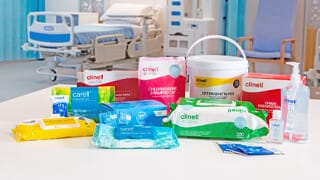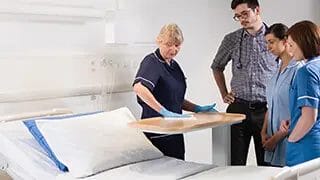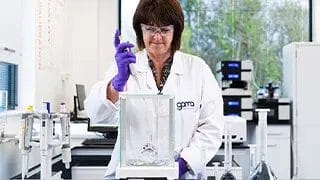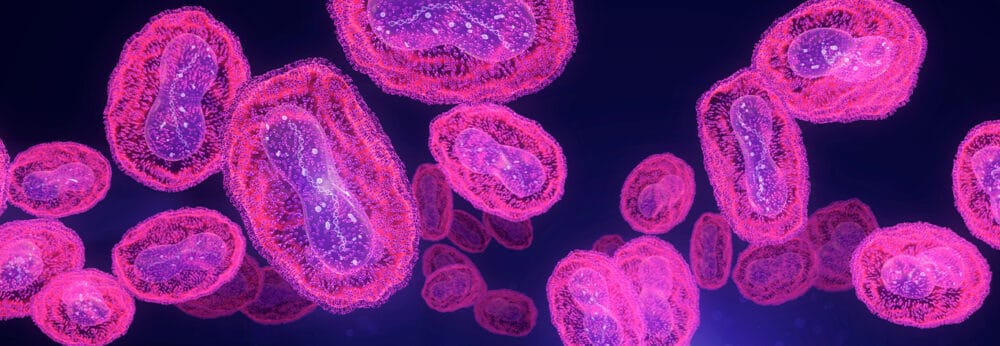Posted
29th September 2021
Products
We give an overview of wet surface biofilms; where you will find them, why they are a threat in healthcare settings and how you can manage them.
There’s a city of microbes living in your drains, and you wouldn’t even know. The cities are biofilms and their residents are multispecies bacteria, which shelter inside protected from the lethal effects of passing disinfectants. Despite infection prevention and control protocols, these cities still stand and will regrow causing costly HCAIs unless correct action is taken.
What’s lurking down the plughole?
In line with correct hand hygiene practice, healthcare workers and patients use hospital facilities to remove the dirt and microbes living on their skin. But that’s not all that ends up down our drains. Contaminated wastewater (and not to mention the last few mouthfuls of coffee) will end up down there too. While certain sinks might be given certain functions, likelihood is that they all share two things: drains and biofilms.
Drains are fed with bacteria, which in warm and wet conditions, can attach to surfaces, set up camp and change state. During this transformation, they secrete sugars and proteins which form a complex web of extracellular polymeric substances (EPS). This matrix, known as a biofilm, protects the drains’ residents from traditional disinfection techniques.
The established biofilms are fed by nutrients that are also washed down the plughole, enabling them to grow. Water running into the contaminated sinks and showers can splash microbes onto nearby surfaces, the hands of healthcare workers and patients.
Infection prevention and control strategies
As IPC specialists fighting against infection, we need to think strategically about the tactics we decide to employ. Everyday we’re faced with familiar opponents: MRSA, C. diff, CPE and Gram-negative bacteria – to name a few. From experience and education, we select products and protocols that prevent and control infection.
Antibiotic resistance is a bigger threat than ever before. Not all bacteria are the same and while all are single-cell organisms, they vary significantly in how they look and behave. Some can change themselves to survive previously lethal antibiotics. With resistance growing, we must focus on the offensive rather than defensive strategy: prevention.
Traditional strategies aren’t working
Chlorine-based disinfectants are often used to treat drainage systems in the fight against biofilms. Free-floating microbes outside of the biofilm will be killed by traditional disinfectants, but the structure protecting the city cannot be penetrated. Left intact, the microbe population will regrow rapidly and continue to pose a threat.
You might be left wondering: what can we do to stop them? Some suggestions include introducing physical barriers or totally replacing hospital hardware. While these could alter the immediate threat, they won’t stop biofilms regrowing and seeding microbes into our environment.
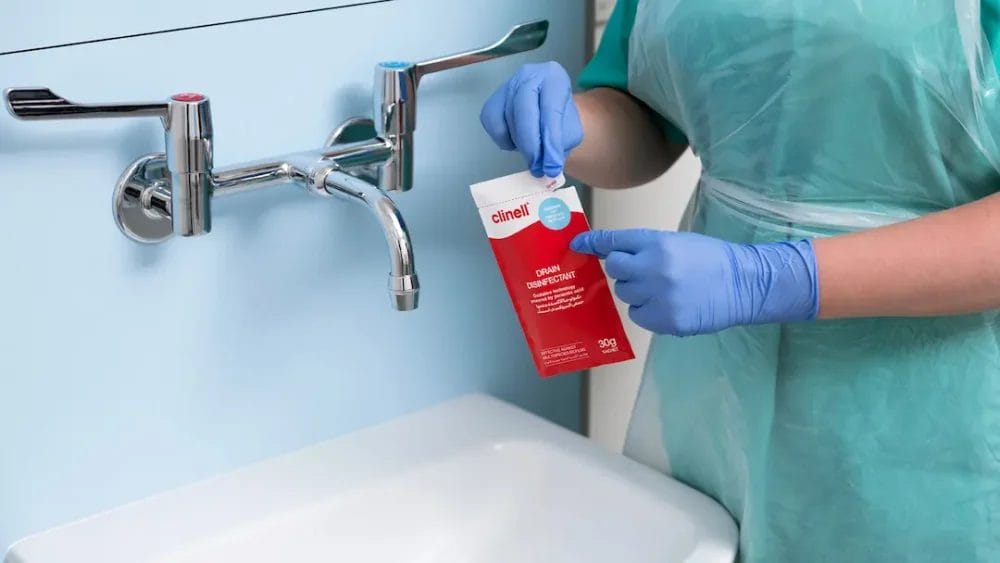
Peracetic acid: oxidative technology to wipe out biofilms
The residents of drain-based biofilms are up there with the hardest-to-kill microorganisms. When looking at potential disinfectants that can be used to tackle them, we should consider:
- Log reduction: The higher the better. Log 1 provides 9% decontamination, log 2 = 99%, log 3 = 99.9%…
- Prevention of regrowth: The longer the better
Peracetic acid is proven to outperform chlorine-based (sodium hypochlorite) disinfectant in both criteria.[1] As a strong oxidising agent, peracetic acid breaks down biofilms and kills >99.9999% of bacteria living inside. It achieves this by altering their chemical stability through oxidation, forcing cells to rupture.
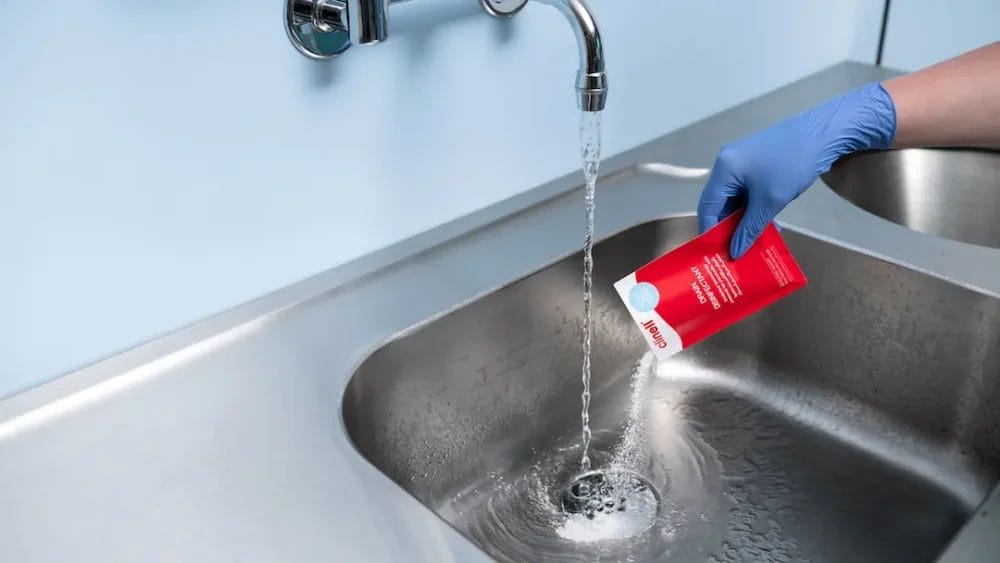
Breaks down biofilms and prevents regrowth for 4 days
Clinell Drain Disinfectant utilises the power of peracetic acid. Despite its strong efficacy and name, the active ingredients in Clinell Drain Disinfectant work at a near-neutral pH and break down to non-toxic by-products. Its unique granular formulation means that one sachet, when combined with water in the drain, generates enough powerful oxidative agents to break down biofilms at the source. Unlike traditional disinfectants, it is strong against microbes and gentle on drains.
At Cardiff University, researchers have created a hyper-realistic drainage tap model impregnated with wet biofilms. They put Clinell Drain Disinfectant to the test and compared it to traditional disinfectants. Drain Disinfectant was found to have higher anti-biofilm activity than chlorine-based disinfectants (NaOCl 1000ppm). Unlike chlorine, it eradicated biofilms throughout all sections of the drainage tap and prevented regrowth for at least 4 days.
For more information, head to our Drain Disinfectant page or to arrange a trial, contact one of GAMA’s Area Managers. Help us spread the word about biofilms, by sharing this article on social media.
[1] Ledwoch K, Robertson A, Lauran J, Norville P, Maillard JY. It’s a trap! The development of a versatile drain biofilm model and its susceptibility to disinfection. J Hosp Infect. 2020;106(4):757-764. doi:10.1016/j.jhin.2020.08.010
SHARE THIS ARTICLE
Tags
Latest News
Celebrating 20 Years of GAMA Healthcare: Our Story
This month, GAMA Healthcare celebrates 20 years of helping prevent…
Norovirus: Understanding its transmission and prevention in the UK
Introduction Norovirus is recognised as the leading cause of viral gastroenteritis…
Clean Between to Reduce Healthcare-Associated Infections
Healthcare-associated infections (HAIs) are a significant concern for healthcare facilities…
Mpox: emergence of a new threat
A new threat related to mpox is emerging, in the…

